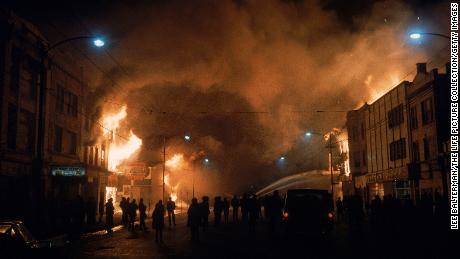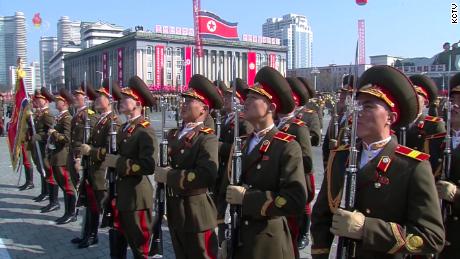The most turbulent time in modern American history (it's not now)
Updated 1610 GMT (0010 HKT) May 18, 2018
(CNN)A president with low approval ratings. Tensions between the US and North Korea. Athletes protesting racial injustice. Bitter divisions threatening to rip our country's social fabric apart.
Sound familiar? But we're not talking about 2018.
All this happened 50 years ago, in 1968.
Echoes of that year, considered by many the most turbulent in modern US history, can be found in today's headlines about President Trump, social protests and shocking acts of gun violence. Our country has changed immensely -- the internet, a black president, same-sex marriage -- since then. And yet, some things feel eerily similar.
"Yes, it's a continuation," says Charles Kaiser, author of "1968 in America: Music, Politics, Chaos, Counterculture, and the Shaping of a Generation," about parallels between 1968 and now. "We're certainly still fighting many of the same battles."
Here are five of them.
Our embattled president was warring with the media
Lyndon B. Johnson, thrust into the presidency after the assassination of John F. Kennedy, enjoyed widespread support during his first years in office. But by the summer of 1968, his approval rating had plummeted to 35%.
The main reason was the war in Vietnam, which was going increasingly poorly. The North Vietnamese's Tet Offensive earlier that year had dashed any hopes for a swift end to the war. Americans' appetite for the conflict was waning, and anti-war protesters filled the streets of US cities.
Caught between hawks who urged him to send more troops to Vietnam and doves who wanted him to pull out, LBJ trod a middle path that pleased almost no one. A fractured Democratic Party turned against him.
He also faced an increasingly hostile press corps who suspected he wasn't being candid about what was happening on the ground in Vietnam.
In March, Johnson stunned the nation by saying he would not seek re-election.
Fast forward to today, and while we're not at war, you see some similarities with President Trump. His approval ratings have mostly hovered under 40%, although they have ticked up lately.
Trump has had an antagonistic relationship with the news media, refusing to grant interviews to outlets he views as unsympathetic and blasting stories he doesn't like as "fake news." In return, many media outlets have repeatedly called him out over false statements.
Meanwhile, he's faced vociferous protests from women, students and intellectuals -- three groups that also opposed LBJ.
We were locked in a tense war of words with North Korea
Trump spent much of his first year mocking North Korean leader Kim Jong Un on Twitter, calling him "Little Rocket Man" and urging then-Secretary of State Rex Tillerson not to negotiate with the totalitarian nation. Meanwhile, North Korea launched dozens of test missiles into the ocean and made vague threats about topping long-range missiles with nuclear warheads.
Tensions between the two countries peaked in January, when Trump warned Kim about US nuclear capabilities and boasted of his "much bigger & more powerful" nuclear button. The inflamed rhetoric alarmed many Americans who feared it would lead to a nuclear attack.
Things have calmed down since then, and the two leaders are tentatively set to meet next month in Singapore amid indications that North Korea may scale down its nuclear weapons program.
But in 1968, an equally frightening episode brought the two countries to the brink of war.
On January 23 that year the USS Pueblo, a Navy intelligence vessel, was seized by North Korea, which accused the vessel of illegally spying in North Korean territorial waters. Its 83-man crew was transported to Pyongyang, imprisoned and tortured by interrogators who demanded they sign "confessions."
After 11 months of delicate negotiations, the seamen were freed that December. But classified documents show tensions between the countries got so high that US military leaders drafted a secret plan to defend South Korea against a possible second invasion by the North.
Now, 50 years later, the surviving USS Pueblo crew members and their relatives are suing North Korea over their treatment while in captivity.
Black athletes were making symbolic protests against racism
On October 16, 1968, US sprinters Tommie Smith and John Carlos won gold and bronze medals in the 200 meters at the Summer Olympics in Mexico City.
The two African-American men took the medals podium barefoot, bowed their heads and raised their fists in Black Power salutes as the national anthem played. A famous photo of their silent protest was front-page news around the world.
The backlash was swift. The pair were kicked off the US Olympic Team and faced death threats upon returning home.
"There was a lot of misunderstanding about what was happening because they had never seen that happen before, especially by a black athlete," Smith told CNN in 2016. He said his "human rights" salute "represented those who did not have a platform."
Almost half a century later, San Francisco 49ers quarterback Colin Kaepernick touched off another firestorm when he chose to sit -- and later kneel -- during the national anthem before NFL games to protest systemic racism in America.
Like Smith's and Carlos', his protest was symbolic and silent. Unlike theirs, it gradually caught on with other athletes, spreading to college and even high school games across the country. On several Sundays last fall, hundreds of NFL players took a knee during the anthem in response to President Trump's call for NFL owners to fire any "son of a bitch" who "disrespects our flag."
But Kaepernick, too, has paid a price for his principles. He has been out of work since the 2016 season and last fall filed a grievance against the NFL, claiming team owners colluded to keep him out of the league.
We were traumatized by shocking acts of violence
More than anything, the chaos of 1968 was exemplified by two seismic spasms of gunfire, just nine weeks apart.
On April 4, the Rev. Martin Luther King Jr. was fatally shot by a lone assassin in Memphis, prompting an outpouring of grief and anger in African-American communities around the nation. Chicago, Washington, D.C., and dozens of other cities erupted in riots that lasted for several days.
Sixty-three days later, Sen. Robert F. Kennedy was gunned down in Los Angeles only hours after winning California's presidential primary.
The two assassinations threw the nation in turmoil. The idealism of the early 1960s, symbolized by America's youthful new president, was gone, replaced by a creeping cynicism and an unease that the fabric of American society was coming apart.
Some people have described the same destabilizing feeling over the past year as the US has been wracked by terror attacks and mass shootings. In one horrific span of four-and-a-half months, gunmen mowed down dozens of innocent victims in Las Vegas; Sutherland Springs, Texas; and Parkland, Florida, and a man in a rented truck killed eight people on a busy bike path in New York City.
The death toll from these tragic acts is much higher now than in 1968, but in a post-9/11, post-Sandy Hook, post-Pulse era, the sense of shock may not be any greater.
"We are inured to it (gun violence) in a way that we weren't in 1968," says Kaiser, the "1968" author. Back then, he says, "you just felt like like all the old standards were going out the window."
Women were speaking up for their rights
In September 1968, several hundred feminists converged on Atlantic City, New Jersey, to protest outside the annual Miss America pageant, complaining that it oppressed women and promoted misogynistic attitudes about beauty.
Protesters carried signs saying, "Let's judge ourselves as people," and dumped girdles, mops, copies of "Ladies' Home Journal" and other items seen as manifestations of oppression into a "freedom trash can" on Atlantic City's boardwalk.
They weren't successful in shutting down the pageant, which is still held today (although it will now be led entirely by women). But the protests helped spur a new wave of feminism that continued into the 1970s and beyond.
Signs of their efforts can be seen in the Women's March, which drew hundreds of thousands of female protesters to cities around the country the past two years to lobby for women's rights and rebuke vulgar comments by President Trump. They also can be seen in the recent #MeToo and #TimesUp movements to combat sexual harassment and violence against women.
"You can draw a direct line from the Miss America protests to the sexual harassment stuff," says Kaiser.
So in 50 years we have learned ... what?
When the fractious America of 2018 looks in the mirror, it can see traces of its younger self, half a century ago.
Our country has evolved and grown up since then. Bigotry is no longer acceptable. Women are assuming more positions of leadership. We have smartphones.
And yet in other ways we haven't learned anything from the turmoil of 1968. Again, Washington is in chaos. Again, we have thousands of US troops in an interminable and unpopular conflict halfway around the world. Again our nation, plagued by conflict and bloodshed, is on edge.
To paraphrase F. Scott Fitzgerald, we're like boats against the current, borne back ceaselessly into the past -- and doomed to repeat it.
Yes, our current period of American history feels crazy. But if someone tries to tell you that none of this has ever happened before, remind them of 1968.















